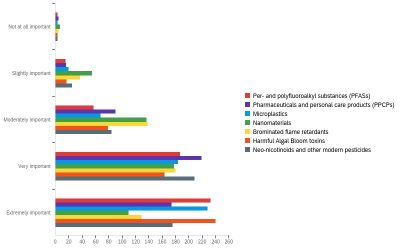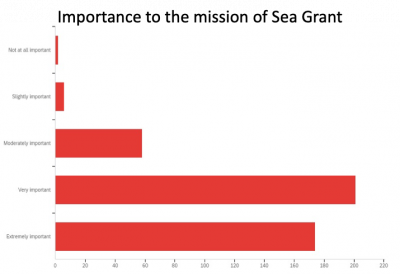By Judy Benson
Manmade chemicals known as PFAS and microplastics emerged as the top concerns of the 646 people who responded to a survey conducted in late 2021 by the Contaminants of Emerging Concern Project.
The project is being led by the Connecticut, New Hampshire and North Carolina Sea Grant programs along with Lighthouse Consulting Group.
Results of the survey are being used to identify a strategic role for Sea Grant, and develop a research initiative for the Atlantic Coast, following a series of region-specific informational workshops, and education and extension projects focusing on CECs. Five workshops are planned: one each for the Southeast and Mid-Atlantic; Gulf of Mexico; Northeast; Great Lakes; and West Coast.
“In order to make strategic investments in the relatively novel field of Contaminants of Emerging Concern, it is important to get the pulse of our stakeholders and partners and assess potential regional differences,” said Sylvain De Guise, director for Connecticut Sea Grant and project lead.

CECs generally are the chemical residues of various types of industrial, pharmaceutical, personal care and agricultural products that are increasingly found in the environment but are largely unregulated and their impacts not well understood. PFAS—per and polyfluoroalkyl substances—are a family of widely used chemicals that break down very slowly and can accumulate in people, animals and the environment over time. More than 81% of respondents ranked PFAS and microplastics—microscopic shards that fray off larger plastic items—at “very important” or “extremely important” areas of focus for research. But high interest was also expressed for research into other categories, including pharmaceuticals and personal care products; toxins from harmful algal blooms; flame retardants; nanoparticles and neo-nicotinoids and other pesticides.
Survey respondents strongly affirmed that CEC projects are in keeping with the mission of the nation’s 34 Sea Grant programs. One of the main purposes of the project is to define a role for Sea Grant programs pertaining to CECs that complements the efforts of other agencies.
The survey was distributed nationwide. While most respondents were from the Northeast, Mid-Atlantic and Southeast, there was significant participation from all coastal regions of the country. Responses were submitted anonymously, although participants did identify broad professional affiliations. The majority of respondents identified as academics, followed by staff of Sea Grant programs nationally, and state and federal employees. Smaller groups were affiliated with non-profit organizations, for-profit companies, local governments, or identified as students or interested citizens.
Respondents highlighted estuaries, coasts and fish as possible areas of focus for Sea Grant CEC projects, while also urging that broader concerns about watersheds and the connections between human and ecosystem health not be excluded. Wastewater treatment plants and effluent, stormwater and drinking water rose as leading areas of interest for projects focusing on infrastructure and CECs.
In response to several open-ended questions, respondents said there is a need for basic education about CECs and urged that environmental justice considerations be built into the project. Many noted that urban, low-income, tribal and other underserved communities are most impacted by CECs due to current and legacy industrial pollution, lack of resources for infrastructure improvements and other factors.
“The project team is thankful for the community responses, which will help draft a strategic vision for Sea Grant in the field of Contaminants of Emerging Concern, and guide future investments,”, concluded De Guise.

Learn more about the Contaminants of Emerging Concern Project here.
Judy Benson is the communications coordinator at Connecticut Sea Grant.